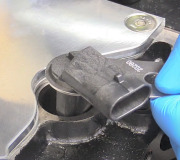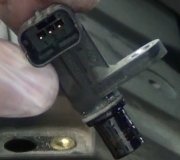P0342 - Camshaft Position Sensor Circuit Low Input
Sounds like you have your mechanics turned around. Actually, diagnostic fault codes never say to replace parts or that they're defective. When a sensor is referenced in a fault code, as in this one, that part is actually the cause of the code about half of the time so the logical fastest way for the first mechanic to save you money on diagnostic time is to simply replace it and see if the problem is solved.
Fault codes only indicate the circuit or system that needs further diagnosis or the unacceptable operating condition. Unless the mechanic has the correct part in stock already, the proper procedure is to do some tests and visual inspections on the wiring to rule everything else out, THEN buy the part once it appears that will be the fix.
You didn't say why you bounced to a second mechanic but my suspicion is you were dissatisfied with the first one because he didn't solve the problem right away. We do that with doctors too, but we hold mechanics to much higher standards than doctors. When a doctor doesn't cure us, we run off to a different one, perhaps multiple times, and each one has to start the diagnosis all over again. Your first mechanic should have been allowed to continue because many repairs on today's complicated cars require so many diagnostic steps and procedures, there's no way they can all be done in one visit. Your second mechanic took over in the middle of someone else's diagnosis and had to make assumptions, (usually incorrectly), on what the first mechanic did and accomplished.
There is nothing to reset to solve a running problem. The second mechanic was likely trying to erase the diagnostic fault code and / or turn off the Check Engine light, but that alone won't solve the hesitation. Once erased, if that code comes right back, it proves the new sensor didn't solve the problem, but it doesn't prove the old one was okay. It's not common to have multiple causes for one problem, but a typical example would be when water gets into a connector and the terminals for the sensor and for the plug become corroded. You may need a sensor and a new plug. In that case replacing either one is not the total fix. This is where the first mechanic needs to be given the chance to continue on.
As you can see from this fault code, it refers to the voltage from the sensor that is seen by the Engine Computer. This is a perfect example of where it's important to look for a wiring harness that has been rubbing on a sharp metal bracket or has fallen down onto hot exhaust parts and melted through. The signal voltage for this type of sensor switches from "low", (typically 0.2 volts) to "high", (typically 5.0 volts or 8.0 volts). Most manufacturers use 5.0 volts on the signal wire that is pulsed, or "drawn down" to 0.2 volts to create the signal that is understood by the computer. Since we know now that we can rule out the sensor being shorted, the first suspect is a grounded signal wire. Testing of that wire's resistance is the next step, and either mechanic should be able to handle that if they understand basic electrical theory.
There can be mechanical causes too for this but those are much less common. All of this type of sensor use a magnet and require some metal part, usually with gaps, holes, or teeth moving past that magnet to generate the signal pulses. The size of the air gap between the tip of the magnet and the moving part is important too, and on some engines and sensors, that is adjustable and critical. This is a case where an old sensor could have been defective, but the problem still exists due to improper installation procedures of the new one. I don't know if this is the case with your engine, but it gives you an idea of some of the additional things your mechanics need to consider.
Tuesday, January 13th, 2015 AT 3:24 PM



